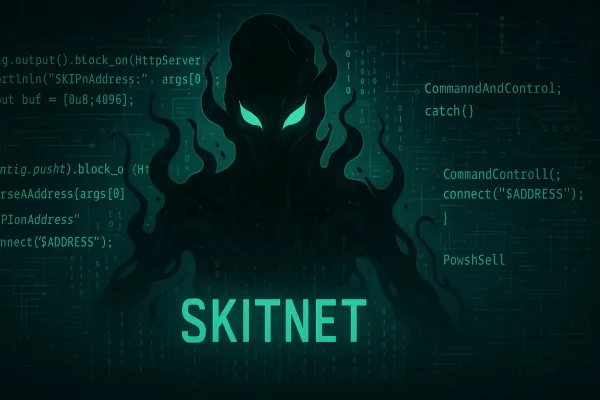
Understanding Skitnet- Evolving Malware Threats and Tactics
In the ever-evolving landscape of cybersecurity, the emergence of sophisticated malware poses significant challenges for security professionals. One such entity, Skitnet (also referred to as Bossnet), surfaced in April 2024 and has rapidly gained notoriety within the security community due to its multi-stage capabilities, stealthy execution, and robust persistence mechanisms. This blog post delves deeply into the operational intricacies of Skitnet, leveraging recent findings and analyses to better understand its mechanisms and the implications for cybersecurity strategies.
Overview of Skitnet
Skitnet is a multi-stage malware package sold on underground forums, featuring an arsenal that combines server components with automated installation scripts. Researchers have identified that it employs programming languages such as Rust, Nim, .NET, and PowerShell to create a versatile, stealthy threat.
Key Attributes of Skitnet
-
Multi-Language Architecture: The malware integrates diverse programming languages, which not only enhances its functionality but also reduces its visibility to traditional detection mechanisms.
-
Automated Installation via Bash Scripts: Skitnet’s design allows for minimal human intervention. It relies on automated scripts to install and execute, facilitating rapid deployment across target systems.
-
Encrypted Payloads: Utilizing ChaCha20 encryption, Skitnet encrypts its payload, making it difficult for conventional security tools to detect and mitigate its effects.
-
Dynamic DNS Communication: Through covert DNS resolution, Skitnet establishes command and control (C2) channels that elude most firewall protections.
Additional Stealth Techniques
Evasion Tactics
Recent analyses have highlighted that Skitnet employs advanced evasion tactics, such as:
-
Manual Mapping in Memory: The initial Rust executable decrypts and directly maps the payload into memory using techniques like DInvoke-rs, effectively avoiding disk checks that security products typically monitor. This behavior aligns with advanced malware tactics that seek to execute in-memory, reducing the chance of detection.
-
Dynamic Function Resolution: By utilizing
GetProcAddress, Skitnet dynamically resolves API functions, thereby circumventing static analysis that often identifies malicious behaviors through predictable import tables.
Persistence Mechanisms
The malware’s persistence techniques reflect a sophisticated understanding of Windows internals:
-
DLL Hijacking: Skitnet exploits legitimate software by introducing malicious DLLs into the applications’ execution paths. By placing a Trojanized version of a legitimate DLL in the same directory as a trusted application, it manipulates the execution flow to execute its scripts.
-
Scheduled Tasks and Startup Scripts: The malware creates persistent entries in Windows Startup folders and employs scheduled tasks to ensure its re-execution, leveraging familiar system behaviors to mask its presence.
Post-Exploitation Capabilities
Once executed, Skitnet becomes a formidable adversary, offering threat actors extensive post-exploitation capabilities, including but not limited to:
-
Screen Capture and Keylogging: Advanced functionalities allow for discreet surveillance and data exfiltration.
-
Deployment of Remote Access Tools: Skitnet can install and use legitimate remote administration software (like AnyDesk or Remote Utilities), further embedding itself within the network and facilitating deeper penetration.
-
Data Exfiltration: Operatives can leverage the malware to steal sensitive information and siphon data through encrypted channels.
Insights from Recent Research
Recent reports indicate that Skitnet has seen increased usage in targeted Ransomware-as-a-Service (RaaS) operations. For instance:
-
In early 2025, affiliates of the ransomware group Black Basta utilized Skitnet during Teams-themed phishing campaigns, illustrating its potential for broader application within the cybercrime ecosystem.
-
Articles from cybersecurity experts like PRODAFT emphasize that Skitnet’s design enables it to perform effective reconnaissance, data theft, and facilitate lateral movement within corporate environments, emphasizing a shift in attack strategies toward more stealth-oriented techniques.
Current Mitigation Strategies
Given the complexity of Skitnet, organizations need to enhance their threat detection capabilities by considering the following strategies:
-
Behavioral Analysis: Shift focus from signature-based detection to behavioral and heuristic analysis to identify anomalous actions indicative of Skitnet’s operation.
-
Endpoint Detection and Response (EDR): Employ EDR solutions capable of real-time monitoring and automated response to unauthorized modifications and behaviors.
-
User Awareness Training: Educate employees about social engineering tactics and the significance of email and link scrutiny to prevent the initial compromise.
-
Regular Software Updates and Patch Management: Conduct regular audits and ensure that all software and operating systems are up-to-date to mitigate vulnerabilities that Skitnet could exploit.
Conclusion
Skitnet represents a significant evolution in malware, showcasing the clever fusion of multiple programming languages, stealth techniques, and execution strategies to create a resilient and flexible threat. The rapid adaptation of such malware calls for a robust, forward-thinking approach amongst cybersecurity professionals to defend against an increasingly sophisticated threat landscape. Skitnet’s case illustrates the need for continuous learning and adaptation within the cybersecurity community, emphasizing the importance of staying ahead of emerging threats through proactive measures and comprehensive incident response strategies.
As we advance, it becomes increasingly imperative for cybersecurity teams to collaborate and share intelligence around these evolving threats, reinforcing our collective defenses against sophisticated malware like Skitnet.